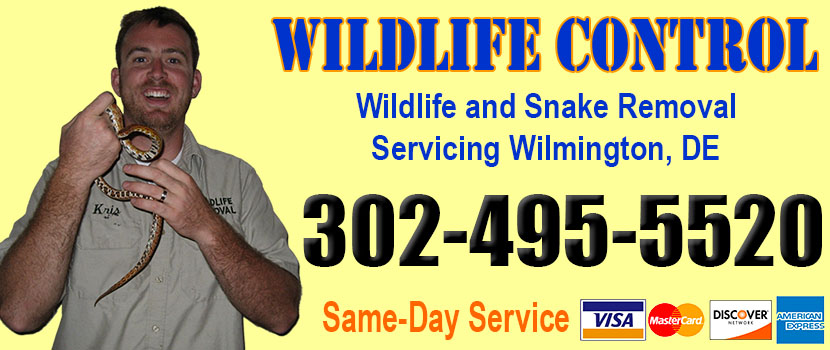
Welcome to wilmingtonsnakes.com! I am David, a snake enthusiast living in Wilmington, DE. Many people don't know that Wilmington is in fact full of snakes! You just need to know where to find them - they can often be shy and elusive. Some Delaware snake species are more common outside of the city limits, in different parts of New Castle County DE, but many types of snakes are indeed common in the more urban parts of Wilmington. This guide is meant to help educate you about the beautiful snakes of Wilmington, and to help you identify the most common snakes of Wilmington, as well as the venomous snakes of Wilmington that you should learn to recognize and avoid. If you want more detail, click here for my complete list of ALL snake species in Wilmington. Remember the following:
- Most snakes of Wilmington are harmless and don't want to encounter you
- Venomous snakes exist but are uncommon in Wilmington, Delaware
- Snakes eat rats and mice and are a valuable part of the Delaware ecosystem
- Never kill a snake - if you leave a snake alone, it will leave you alone.
Common Snake Species in Wilmington
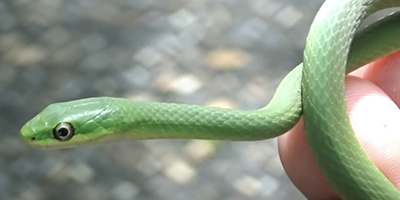 Northern rough green snake:
The northern rough green snake is a small to average-sized snake. It is slender and known for the bright green scales on the top of its body. The bright green scales make the northern rough green snake standout and hence, where it gets its name. When you observe the northern rough green snake ventrally, it is uniformly colored throughout in either green, cream, or yellow. The dorsal scales are not smooth which results in 17 keeled scales in the middle of the body. Adults can grow up to 4 feet; it has a very long tail since it takes up 1/3 of its entire length. There is not much difference in appearance between male and female northern rough green snakes and size is the only factor that differentiates them.
Northern rough green snake:
The northern rough green snake is a small to average-sized snake. It is slender and known for the bright green scales on the top of its body. The bright green scales make the northern rough green snake standout and hence, where it gets its name. When you observe the northern rough green snake ventrally, it is uniformly colored throughout in either green, cream, or yellow. The dorsal scales are not smooth which results in 17 keeled scales in the middle of the body. Adults can grow up to 4 feet; it has a very long tail since it takes up 1/3 of its entire length. There is not much difference in appearance between male and female northern rough green snakes and size is the only factor that differentiates them.
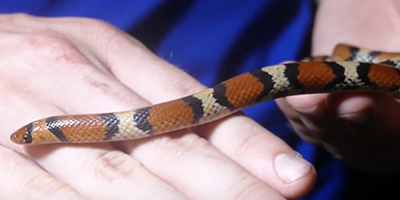 Scarlet snake:
The scarlet snake is generally considered to be a small snake of only 14-26 inches. Dorsally, the scarlet snake has a pattern and is of light gray color surrounded by blotches around the borders in red or black. The belly of the scarlet snake is uniformly white and light gray. The blotches run down the side of the scarlet snake.
Scarlet snake:
The scarlet snake is generally considered to be a small snake of only 14-26 inches. Dorsally, the scarlet snake has a pattern and is of light gray color surrounded by blotches around the borders in red or black. The belly of the scarlet snake is uniformly white and light gray. The blotches run down the side of the scarlet snake.
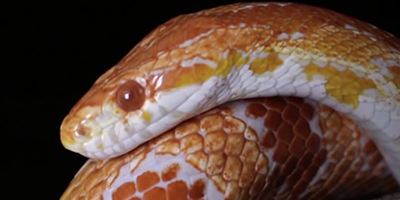 Corn snake:
Corn snakes are very thin and slender snakes (24-72 inches) that are usually orange or brown. The patterns on their body resemble that of blotches which are bright red and run down the corn snake's back. They are often known as red rat snakes. Under their bodies, towards their belly is a prominent checkered pattern that is formed through multiple rows of black and white lines and marks. One factor to note is that the pattern and color of corn snakes depend on the age and the location of the corn snake. Young corn snakes are generally not as bright as adult corn snakes. Corn snakes are generally the most active during the day and hunt during this time.
Corn snake:
Corn snakes are very thin and slender snakes (24-72 inches) that are usually orange or brown. The patterns on their body resemble that of blotches which are bright red and run down the corn snake's back. They are often known as red rat snakes. Under their bodies, towards their belly is a prominent checkered pattern that is formed through multiple rows of black and white lines and marks. One factor to note is that the pattern and color of corn snakes depend on the age and the location of the corn snake. Young corn snakes are generally not as bright as adult corn snakes. Corn snakes are generally the most active during the day and hunt during this time.
Venomous Snake Species in Wilmington
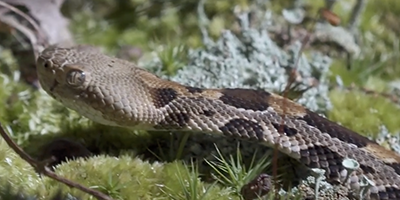 Timber Rattlesnake:
The timber rattlesnake is a venomous snake that can vary in its color; it can be gray with tones of pink and can also have a stripe that runs smoothly and finely down the snake's back. The color of the stripe can have variations, it can be orange, pink, and even yellow. Some timber rattlesnakes just have a dark black or brown fine stripe on their body hence, showcasing a varying trend in their color along with the color of the stripes. At the tip of its tail, the rattlesnake has a rattle that comes to attention as soon as it feels a threat nearby; this results in a rattle-like sound. The sound can be heard before the timber rattlesnake decides to strike, however, usually in most cases it does not strike and remains docile. Even though they do not bite often, a person needs to see a doctor immediately if bitten by a timber rattlesnake as the venom can be lethal if not treated medically on an immediate basis.
Timber Rattlesnake:
The timber rattlesnake is a venomous snake that can vary in its color; it can be gray with tones of pink and can also have a stripe that runs smoothly and finely down the snake's back. The color of the stripe can have variations, it can be orange, pink, and even yellow. Some timber rattlesnakes just have a dark black or brown fine stripe on their body hence, showcasing a varying trend in their color along with the color of the stripes. At the tip of its tail, the rattlesnake has a rattle that comes to attention as soon as it feels a threat nearby; this results in a rattle-like sound. The sound can be heard before the timber rattlesnake decides to strike, however, usually in most cases it does not strike and remains docile. Even though they do not bite often, a person needs to see a doctor immediately if bitten by a timber rattlesnake as the venom can be lethal if not treated medically on an immediate basis.
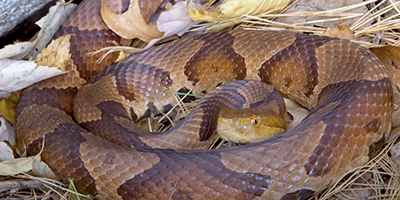 Northern copperhead:
Northern copperheads are snakes that are known for their thick bodies and not so smooth scales. They have no patterns or markings on their head like most snakes. They are rather plain with their copper-colored bodies and crossbands. Interestingly, their crossbands are shaped like an hourglass which makes their crossbands standout and look prominent on their copper-colored skin. The northern copperhead has one standalone row of scales. Northern Copperheads have fangs through which they release venom to weaken their prey. The larger the snake is the larger its fangs will be.
Northern copperhead:
Northern copperheads are snakes that are known for their thick bodies and not so smooth scales. They have no patterns or markings on their head like most snakes. They are rather plain with their copper-colored bodies and crossbands. Interestingly, their crossbands are shaped like an hourglass which makes their crossbands standout and look prominent on their copper-colored skin. The northern copperhead has one standalone row of scales. Northern Copperheads have fangs through which they release venom to weaken their prey. The larger the snake is the larger its fangs will be.
If you're unsure, you can email me a photo of the snake at info@wilmingtonsnakes.com and I will email you back with the snake's species. If you found a snake skin, read my Found a Skin? page, and you can email me a photo of the skin, and I'll identify the snake for you. If you need professional Wilmington snake removal help, click my Get Help page, or see the below website sponsor I found, who provides that service.
If I Find A Nest Of Snakes, What Should I Do?
What to Do About Snake Nests
Snake nests can cause a great deal of pain and trouble for you. Snakes have the potential to be dangerous, problematic creatures, and a nest is only going to make matters worse. You do not want one snake on your property, let alone a whole nest of them. Dealing with a nest of snakes, however, is not going to be an easy task. Whatever type of snakes you have there, you are going to need to approach this with care and a plan. With the risks you take here, you cannot wait around or go in blindly. You need to keep yourself safe and you need to do this the right way.
Know the Type of Snake
Not all snakes are the same. How you handle a venomous snake is not how you handle a nonvenomous snake. Handling a venomous snake without care or thought may lead to a bite, which may put your health and life at risk. If you are uncertain of the type of snake on your property, try to get a good look at it. Look at it carefully and see its color, shape, size, and eyes. If you can get a good idea of its appearance, you can figure out what it is. Look online at snakes local to your area. Lists like this are easy to find and will give you photos of every type of snake in your region. You can compare the photos to what you have on your property. In many areas, there are no local venomous snakes. In that case, it is not going to be much of a concern.
How to Remove the Snake and Nest
If the snake is venomous, you should do nothing. Unless you have experience with venomous snakes and know what you are doing, and have the appropriate skills and tools, you are taking too large of a risk. Contact professional services to do it for you. If the snake is not venomous, you can remove it yourself without assistance. Assistance is available if necessary, but there are few risks to doing it on your own. You can use traps or you can grab the snake and place it in a container. So long as you wear protective gear, the risks of a bite are low and you should be safe. Remove the snake and nest and place them far enough away from your property. A snake nest does not have to be a problem for you. They are easy to remove, so long as they are not venomous. Know what you are getting into and be smart about it and you will see positive results.
Remember, the term is not poisonous snakes of Wilmington, it's venomous snakes of Wilmington. Poison is generally something you eat, and venom is injected into you. That said, dangerous snakes are very rare in Wilmington. The few venomous snakes of New Castle County are rarely seen. But they are commonly misidentified, so learn about all the snake species of Wilmington in order to correctly identify them. These snakes are usually also found in the surrounding towns of Wilmington, Newark, Middletown, Bear, Hockessin, Delaware City, Claymont, Elsmere, Odessa, Greenville, Newport, Wilmington Manor, Townsend, Pike Creek, Bellefonte, Glasgow, Ardentow, Edgemoor, Ardencroft, Arden, Brookside, North Star, and the surrounding areas.
Read our article about:
Can I get a pest control company to remove a snake?
wilmingtonsnakes.com domain and hosting costs made possible by the generous support of this sponsor:
